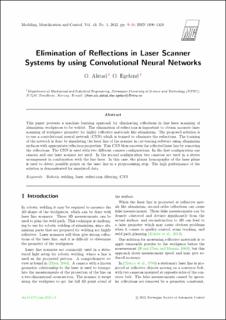| dc.contributor.author | Alstad, Ola | |
| dc.contributor.author | Egeland, Olav | |
| dc.date.accessioned | 2023-02-13T12:26:17Z | |
| dc.date.available | 2023-02-13T12:26:17Z | |
| dc.date.created | 2022-02-10T12:33:25Z | |
| dc.date.issued | 2022 | |
| dc.identifier.citation | Modeling, Identification and Control. 2022, 43 (1), 9-20. | en_US |
| dc.identifier.issn | 0332-7353 | |
| dc.identifier.uri | https://hdl.handle.net/11250/3050386 | |
| dc.description.abstract | This paper presents a machine learning approach for eliminating reflections in line laser scanning of aluminium workpieces to be welded. The elimination of reflections is important to obtain accurate laser scanning of workpiece geometry for highly reflective materials like aluminium. The proposed solution is to use a convolutional neural network (CNN) which is trained to eliminate the reflections. The training of the network is done by simulating the laser line of the scanner in ray-tracing software using aluminium surfaces with appropriate reflection properties. This CNN then recovers the reflected laser line by removing the reflections. The CNN is used with two different camera configurations. In the first configuration one camera and one laser scanner are used. In the second configuration two cameras are used in a stereo arrangement in combination with the line laser. In this case, the planar homography of the laser plane is used to detect possible points on the laser line in a preprocessing step. The high performance of the solution is demonstrated for simulated data. | en_US |
| dc.language.iso | eng | en_US |
| dc.publisher | Norwegian Society of Automatic Control | en_US |
| dc.rights | Navngivelse 4.0 Internasjonal | * |
| dc.rights.uri | http://creativecommons.org/licenses/by/4.0/deed.no | * |
| dc.title | Elimination of Reflections in Laser Scanning Systems with Convolutional Neural Networks | en_US |
| dc.title.alternative | Elimination of Reflections in Laser Scanning Systems with Convolutional Neural Networks | en_US |
| dc.type | Peer reviewed | en_US |
| dc.type | Journal article | en_US |
| dc.description.version | publishedVersion | en_US |
| dc.source.pagenumber | 9-20 | en_US |
| dc.source.volume | 43 | en_US |
| dc.source.journal | Modeling, Identification and Control | en_US |
| dc.source.issue | 1 | en_US |
| dc.identifier.doi | 10.4173/mic.2022.1.2 | |
| dc.identifier.cristin | 1999934 | |
| dc.relation.project | Norges forskningsråd: 295138 | en_US |
| cristin.ispublished | true | |
| cristin.fulltext | original | |
| cristin.qualitycode | 1 | |

